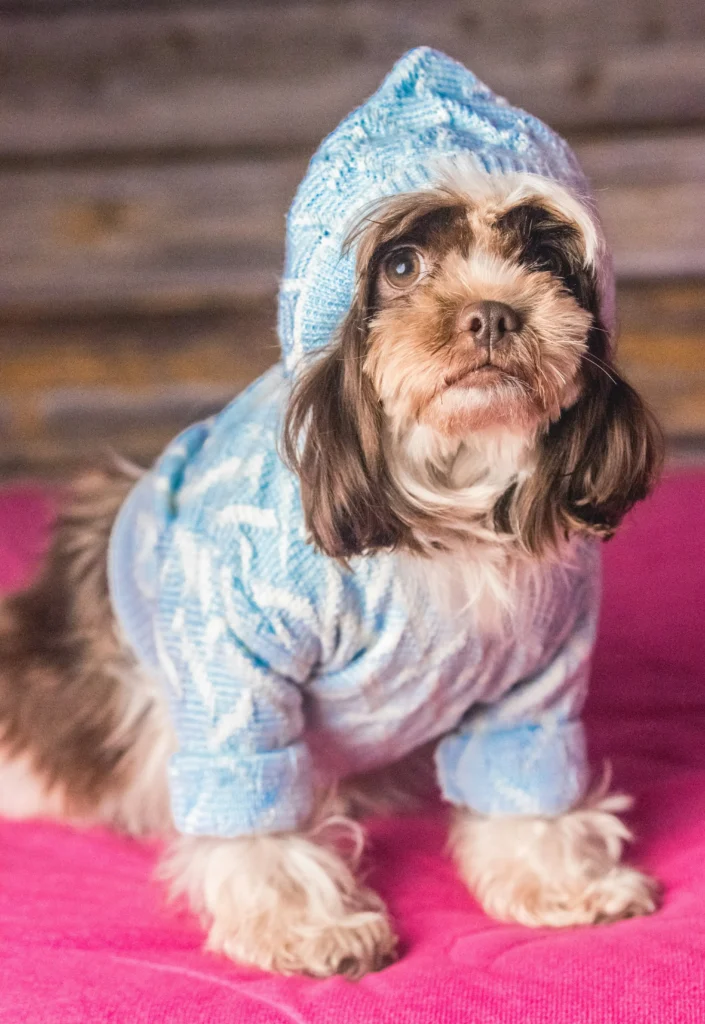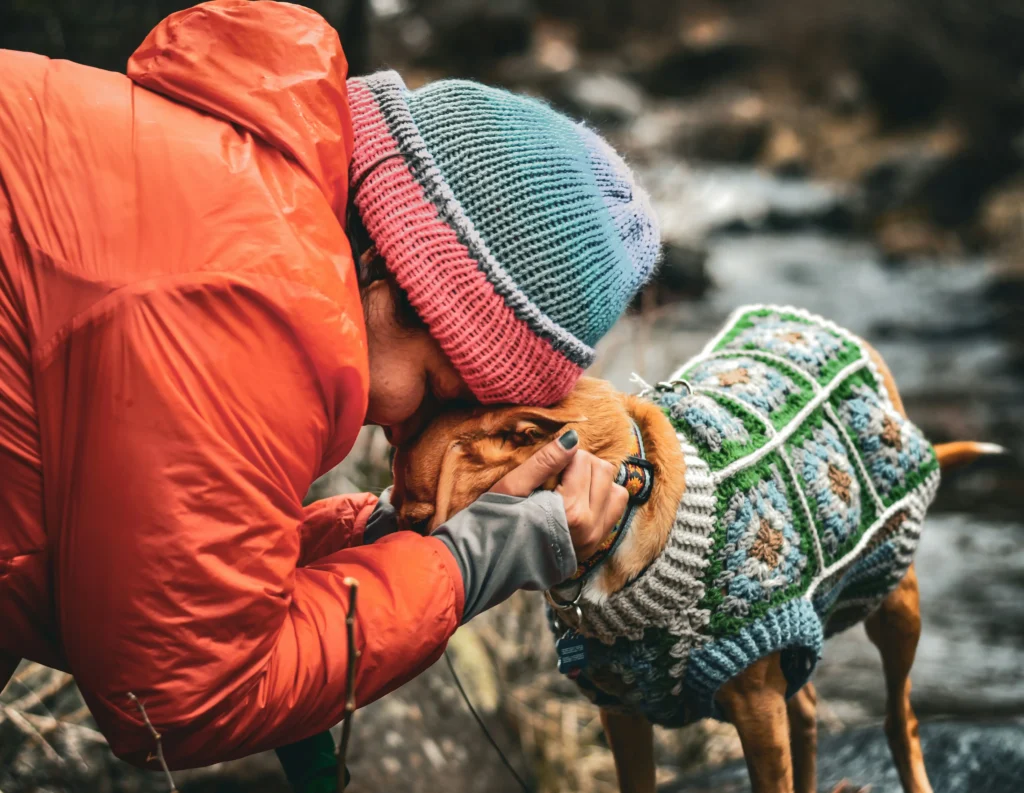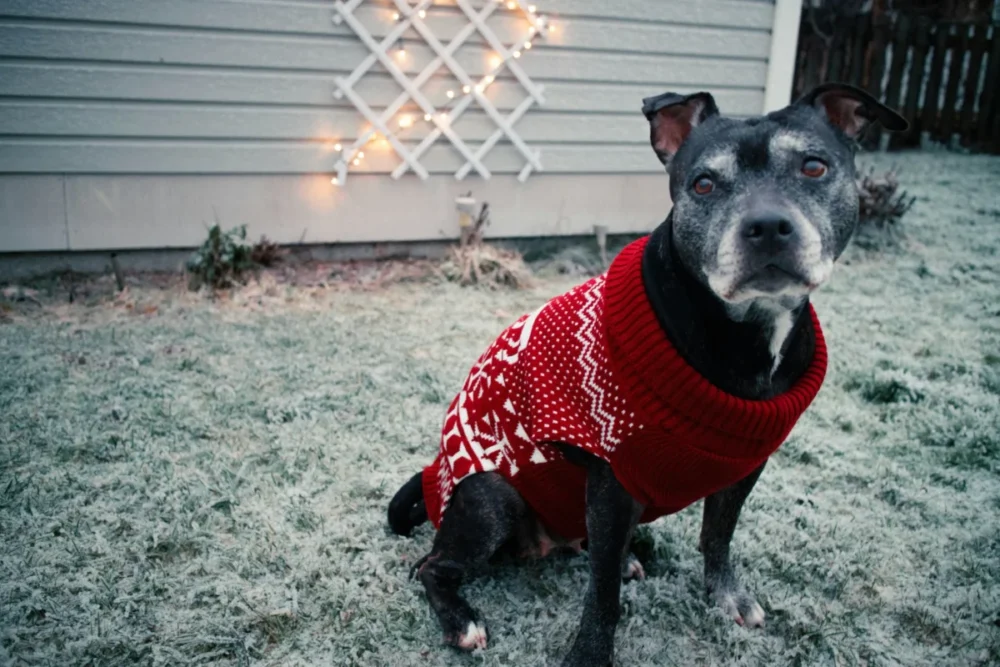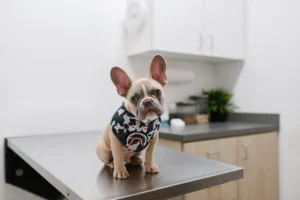Last updated: October 19, 2025
Quick Answer
Measure your Frenchie’s chest, back, and neck—then choose by chest girth first (brands vary). Prioritize designs that are easy to put on and let the shoulders and elbows move freely: step-in vests, front-zip, or wide-neck pullovers with some stretch. Try on, do a short walk test, and exchange if movement looks restricted.
Key Takeaways
- Chest first. French Bulldogs have a broad, deep chest, so chest girth is the make-or-break measurement.
- Movement matters. The sweater shouldn’t pull at the shoulders or pinch the elbows; a short walk and sit test reveals issues fast.
- Easy on/off. Step-in vests, front/side zips, or wide-neck pullovers are usually simplest for the Frenchie build.
- Fabric is a trade-off. Wool = warmth; cotton = breathable; fleece = light and cozy; blends = stretch and shape retention.
- Brands differ. Size charts aren’t universal—when between sizes, sizing up for ease usually works better for Frenchies.
Why Frenchie Shape Changes Sweater Fit
French Bulldogs are compact and muscular with a short neck and a notably broad, deep chest. That’s not a fashion note—it changes how garments hang and flex. A sweater that fits a narrow-chested small breed can feel tight or immobile on a Frenchie. Choosing by chest girth first, then checking neck and back length, keeps the fit practical.
Registries highlight these proportions in their standards. The American Kennel Club (AKC) describes a compact, muscular dog with a broad, deep body. The Kennel Club (UK) and Fédération Cynologique Internationale (FCI) echo this overall build. Linking fit guidance back to these neutral descriptions helps explain why Frenchies often need a different size than other small dogs—especially at the chest and shoulders.
Measure Before You Buy
Tools: soft tape measure, note app or card, brand size chart.
How to measure (in this order):
- Chest girth — around the widest point behind the front legs. This is your primary control.
- Back length — from the base of the neck (not the skull) to the base of the tail. This controls coverage.
- Neck circumference — where a collar would sit. This affects ease of on/off, especially for pullovers.
Between sizes? Because Frenchies are barrel-chested, the safer play is typically to choose the size that accommodates the larger chest and then evaluate overall ease. Always read the brand’s return/exchange policy before removing tags.
60-second try-on routine: Dress your dog, walk 10–15 steps, ask for a sit, and gently lift one paw. Watch for neckline creep, armhole pull, or a hem riding up. If movement looks tight, exchange for a size up or switch to a different design type (e.g., from pullover to zip or step-in).
For health concerns, consult your veterinarian.

Design Types & Dressing Ease
Pullover knits
- Why people like them: Simple, fast, usually fewer parts.
- Frenchie fit note: Needs a wide or stretchy neck and generous arm curves; otherwise it can tug at the shoulders.
- Watch for: Tight ribbing at the neck, narrow armholes, or bunching across the chest.
Step-in / vest styles
- Why they work well for Frenchies: The dog steps in, the belly/chest panel closes, and the pattern often leaves room at the shoulders.
- Watch for: Adequate under-chest coverage without shifting sideways; clean seams that don’t rub.
Front-zip or side-zip
- Why they’re easy: No over-the-head moment; especially handy if your dog dislikes pullovers.
- Watch for: Zipper guards (to protect coat/skin), smooth seam placement, and a chest panel that doesn’t “tent.”
Velcro closures
- Why they’re convenient: Quick on/off and adjustable.
- Watch for: Quality hook-and-loop and placement that won’t snag, plus enough overlap to stay secure.
Feature checklist
- Raglan-style sleeves or deep arm curves for shoulder freedom.
- Some stretch (knit blend or strategically placed panels).
- Flat seams, gentle labels, and a hem that doesn’t curl upward.
- Optional leash portal aligned to your harness point.

Fabrics & Care (Neutral)
- Wool: Excellent warmth and resilience; often needs gentler wash routines.
- Cotton: Breathable and familiar; less insulating when damp.
- Fleece: Lightweight, cozy, and quick-drying; check pilling resistance.
- Acrylic or blends: Good stretch/shape retention and easy care; quality depends on knit density and construction.
Knit vs. bonded fleece: Knits flex more and can be comfier for movement while bonded fleece gives warmth.
Care basics: Follow the garment label, close zips/Velcro before washing, and consider air-drying to protect shape and trim.
Sizing Logic Across Brands
Two “Mediums” are rarely identical. Brands draft patterns differently, and their size blocks can diverge—especially at the chest. Read the chart line by line:
- Match chest range first.
- Confirm neck and back are workable (a slightly long back is often fine if movement is easy).
- Keep tags on until the full try-on test passes.
- Favor retailers with clear exchange windows for first-time sizing.
Photo ID Tips (Checklist)
Use this checklist when you’re comparing fit photos or documenting your own try-on:
- ☐ Lighting: Bright, even lighting (daylight if possible).
- ☐ Angles: Side profile (standing), ¾ front, and straight-on front to see chest and armholes.
- ☐ Neckline: Sits comfortably at the base of the neck; not creeping up.
- ☐ Armholes: No pinching at the elbows; fabric doesn’t “bite” when the paw lifts.
- ☐ Shoulders: No horizontal pull lines or ripples across the upper chest.
- ☐ Hem: Lies flat without riding up over the ribs when the dog moves.
- ☐ Leash portal: Aligns with the harness D-ring if used.
Standards Snapshot
- AKC French Bulldog Standard: https://images.akc.org/pdf/breeds/standards/FrenchBulldog.pdf
- The Kennel Club (UK) Standard: https://www.thekennelclub.org.uk/breed-standards/utility/french-bulldog/
- FCI Standard No. 101: https://www.fci.be/Nomenclature/Standards/101g09-en.pdf
At-Home Fit Test (One Minute)
Dress the sweater fully, then:
- Walk 10–15 steps and watch the shoulders—no hitching or short stride.
- Ask for a sit—no neckline creep or chest buckle.
- Gently lift one paw—no armhole pinch.
If any of these look off, exchange the size or try a different design. Avoid cutting the garment; it can unravel or create rough edges.
For health concerns, consult your veterinarian.
Fabrics, Seasons, and Real-World Use
There’s no single “best” fabric—think about where and how the sweater will be used. A short evening outing might only need a light knit or fleece; travel days call for easy on/off and durable seams. If you use a harness under or over the sweater, note the leash portal placement and whether the fabric catches on hardware.
For longer trips, people often pack two sweaters: one lighter piece for breezy days and one cozier option for colder snaps. Keep both easy to launder, and avoid trims that snag.
FAQs
How is sweater sizing for French Bulldogs different from other small dogs?
The Frenchie’s barrel chest and short neck change how garments sit. A size that fits a narrow-chested small dog can feel tight across a Frenchie’s chest and shoulders. That’s why chest girth is the starting point, followed by neck and back checks.
Which single measurement matters most?
Chest girth. If the chest is too tight, movement suffers—especially at the shoulders and elbows. Once chest is correct, confirm neck opening and back length to refine comfort and coverage.
What should someone do if the dog is between sizes?
Choosing the size that fully accommodates the chest girth usually works better for Frenchies, then checking mobility at the shoulders. If the sweater looks roomy elsewhere, a different design type (step-in, zip) often balances ease and security.
Are pullovers or step-in designs easier for a broad chest?
Step-in vests and front/side zips are easiest for many Frenchies because there’s no narrow neck opening to push through. Pullovers can work well too—look for wide or stretchy necks and generous arm curves.
Which fabrics are simplest to live with?
For everyday use, many owners like cotton blends or fleece because they’re easy to wash and dry. Wool offers warmth and resilience but may need gentler care. Whatever you pick, check knit density and seam comfort.
How can someone tell if a sweater restricts movement?
Watch the shoulders during a short walk: the stride should look normal. During a sit, the neckline shouldn’t creep upward or press in. Lifting one paw should not pinch around the armhole.
Do coat colors change the size a dog needs?
No. Color has no bearing on fit. Size selection always comes back to measurements—especially chest girth—and how the garment moves with the dog.
What return or exchange terms matter for first-timers?
Look for clear windows and try-on policies. Keep tags on until the fit test passes. If in doubt, order from a retailer with straightforward exchanges so you can fine-tune sizing without hassle.
Sources Used
- AKC — French Bulldog breed page: https://www.akc.org/dog-breeds/french-bulldog/
- AKC — French Bulldog Standard (PDF): https://images.akc.org/pdf/breeds/standards/FrenchBulldog.pdf
- The Kennel Club (UK) — Breed Standard: https://www.thekennelclub.org.uk/breed-standards/utility/french-bulldog/
- FCI — Standard No. 101 (French Bulldog): https://www.fci.be/Nomenclature/Standards/101g09-en.pdf
- FBDCA — Breed Club: https://frenchbulldogclub.org/
- UC Davis VGL — Dog coat color overview: https://vgl.ucdavis.edu/panel/dog-coat-color
- UC Davis VGL — French Bulldog panel page: https://vgl.ucdavis.edu/panel/french-bulldog



